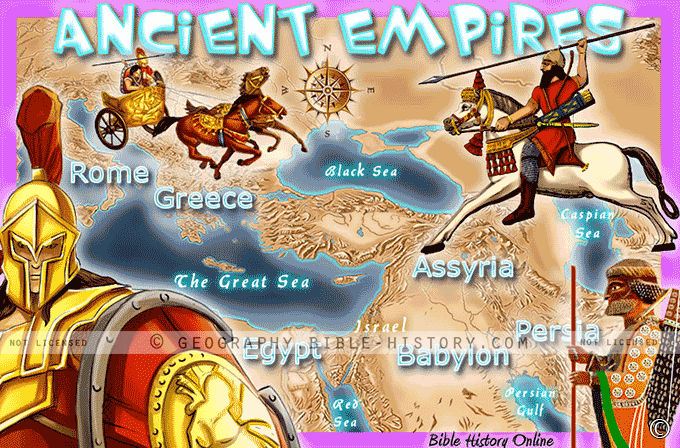
The pages of history are adorned with the tales of ancient empires that rose, flourished, and eventually yielded to the sands of time. These great civilizations, marked by their monumental achievements and far-reaching influence, left indelible imprints on the course of human development. From the grandeur of Mesopotamia to the opulence of Rome, the story of ancient empires is a testament to the heights of human achievement and the cyclical nature of power.
Mesopotamia: The Cradle of Civilization
In the heart of the Tigris and Euphrates rivers, Mesopotamia birthed some of the earliest empires. Sumer, Akkad, Babylon, and Assyria laid the foundations of organized society, introducing writing, laws, and complex urban structures. The ziggurats and epic tales of Gilgamesh illuminate their legacy.
Egypt: Land of Pharaohs and Pyramids
The land of the Nile, Egypt, witnessed the rise of dynastic power with pharaohs ruling as god-kings. Monumental pyramids, advanced engineering, and an intricate religious pantheon defined the empire. The legacy of ancient Egypt endures through its architecture, art, and religious beliefs.
Persia: From Cyrus to Darius
The Achaemenid Empire, led by figures like Cyrus the Great and Darius the Great, spanned from Asia to Europe, showcasing tolerance and cultural integration. The Royal Road, Persepolis, and the Code of Cyrus remain hallmarks of their reign.
Greece: Birth of Democracy and Philosophy
Ancient Greece forged its empires through city-states like Athens and Sparta. Renowned for democracy, philosophy, and art, Greece's legacy lives on through philosophers like Socrates, the Spartans' valor, and the architectural marvels of the Acropolis.
Rome: The Eternal City's Dominion
The Roman Empire's expansion marked the pinnacle of ancient power. From the Colosseum's spectacles to the engineering marvel of aqueducts, Rome's achievements and governance influenced the world. The Pax Romana symbolized a period of relative peace and cultural exchange.
Legacy and Reflection
The legacies of these empires echo through time, impacting culture, language, governance, and art. Their rise and fall serve as a reminder of the cyclical nature of power, the complexity of human endeavor, and the potential for greatness and decline.
Ancient empires stand as the pillars upon which civilizations were built. Their monumental achievements, innovative governance, and cultural contributions have shaped the world we know today. As we journey through the stories of these empires, we encounter the grandeur, the lessons, and the profound echoes of power that continue to resonate across millennia.
Blank Topo Map of The World
Abraham’s Journey
The Captivity of Judah (586-516 B.C.)
The Fall of Judah 586 B.C.
The Northern Kingdom of Israel
The Southern Kingdom of Judah
The Divided Kingdom
The Fertile Crescent
Ur of the Chaldees
Shechem in Old Testament Times
Prophets, Kings, and Nations
Jesus Last Passover
New Testament Israel
New Testament Places
Old Testament Israel
Provinces of the Roman Empire
Israel during David’s Kingdom
David’s Kingdom
Cities of the New Testament 4
Cities of the New Testament 3
Cities of the New Testament 2
Mediterranean Sea
Cities of the New Testament
First Century Jerusalem
Empire of David and Solomon
David’s Kingdom
Israel Under Rehoboam
Ophir and Tarshish
The Period of the Kings
Ramoth Gilead
Samaria
Solomon’s Temple
Zarephath and MT Carmel
Jabesh Gilead and Tribes
Judah in the Time of David
Kingdom of Saul
Kirjath Jearim
Michmash
Mount Gilboa in the Time of David
Nob Davids Flight
Shiloh
Israel and Judah
Assyrian Empire Under Esarhaddon
Assyrian Empire Under Sennacherib
Captivity of 10 Tribes
Events in 2 Kings
The Khabur River
Israel and Syria
Captives From Judah
Kingdom of Jeroboam
Mesha’s Kingdom
Pharaoh Necho Battles King Josiah at Megiddo
Babylonian, Mede and Persian Empires
Samaria and Nearby Territories
Syria at its Height
Hebron
Mahanaim
1949 Map of Israel With Boundaries
First & Second Journeys of Paul
Journeys of the Apostles
Paul’s Third Missionary Journey
Saul’s Journey to Damascus and Arabia
Paul’s Final Visits
Paul’s 1st Missionary Journey
Paul’s 2nd Missionary Journey
Paul’s 3rd Missionary Journey
Paul’s Voyage to Rome
Phillip Journeys to Samaria and Gaza
Judah at the Time of Amos
Empire of Alexander the Great
Israel Under the Maccabees
Galilee During Maccabees
Idumea Intertestamental Period
Kingdom of the Ptolemies
Kingdom of the Seleucids
Ptolemaic Egypt Seleucid Asia
The Roman World
Kingdom of Ptolemies and Seleucids
The World During the 6TH Century BC
Mount Horeb
The Red Sea
The Exodus
Ezra’s Journey to Restore Jerusalem
Israel and Judah During Hosea’s Time
The Ancient World
Canaan During the Time of Abraham
The City of Shechem
Supposed Location of the Garden of Eden
The Land of Israel in Genesis
The Jordan River
The Kingdom of Nimrod
Mount Ararat and Mesopotamia
The Descendants
Sodom and Gomorrah
The Kingdom of Egypt
The Hamites
The Kingdom of the Hittites
Ur of the Chaldees
Judah at the Time of Haggai
Jesus Passes Through Samaria
